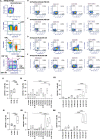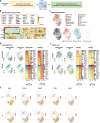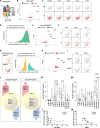PD-1 signaling uncovers a pathogenic subset of T cells in inflammatory arthritis
- PMID: 38254179
- PMCID: PMC10801937
- DOI: 10.1186/s13075-023-03259-5
PD-1 signaling uncovers a pathogenic subset of T cells in inflammatory arthritis
Abstract
Background: PD-1 is an immune checkpoint on T cells, and interventions to block this receptor result in T cell activation and enhanced immune response to tumors and pathogens. Reciprocally, despite a decade of research, approaches to treat autoimmunity with PD-1 agonists have only had limited successful. To resolve this, new methods must be developed to augment PD-1 function beyond engaging the receptor.
Methods: We conducted a flow cytometry analysis of T cells isolated from the peripheral blood and synovial fluid of patients with rheumatoid arthritis. In addition, we performed a genome-wide CRISPR/Cas9 screen to identify genes associated with PD-1 signaling. We further analyzed genes involved in PD-1 signaling using publicly available bulk and single-cell RNA sequencing datasets.
Results: Our screen confirmed known regulators in proximal PD-1 signaling and, importantly, identified an additional 1112 unique genes related to PD-1 ability to inhibit T cell functions. These genes were strongly associated with the response of cancer patients to PD-1 blockades and with high tumor immune dysfunction and exclusion scores, confirming their role downstream of PD-1. Functional annotation revealed that the most significant genes uncovered were those associated with known immune regulation processes. Remarkably, these genes were considerably downregulated in T cells isolated from patients with inflammatory arthritis, supporting their overall inhibitory functions. A study of rheumatoid arthritis single-cell RNA sequencing data demonstrated that five genes, KLRG1, CRTAM, SLAMF7, PTPN2, and KLRD1, were downregulated in activated and effector T cells isolated from synovial fluids. Backgating these genes to canonical cytotoxic T cell signatures revealed PD-1+ HLA-DRHIGH KLRG1LOW T cells as a novel inflammatory subset of T cells.
Conclusions: We concluded that PD-1+ HLA-DRHIGH KLRG1LOW T cells are a potential target for future PD-1 agonists to treat inflammatory diseases. Our study uncovers new genes associated with PD-1 downstream functions and, therefore, provides a comprehensive resource for additional studies that are much needed to characterize the role of PD-1 in the synovial subset of T cells.
Keywords: Inflammatory arthritis; KLRG1; PD-1 agonist; Synovial fluid; T cells.
© 2024. The Author(s).
Conflict of interest statement
The authors declare no competing interests.
Figures




Update of
-
PD-1 signaling uncovers a pathogenic subset of T cells in inflammatory arthritis.bioRxiv [Preprint]. 2023 Nov 17:2023.11.16.566893. doi: 10.1101/2023.11.16.566893. bioRxiv. 2023. Update in: Arthritis Res Ther. 2024 Jan 22;26(1):32. doi: 10.1186/s13075-023-03259-5. PMID: 38014321 Free PMC article. Updated. Preprint.
References
Publication types
MeSH terms
Substances
Grants and funding
LinkOut - more resources
Full Text Sources
Medical
Research Materials
Miscellaneous

